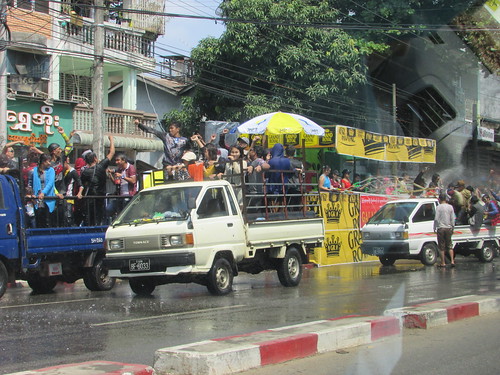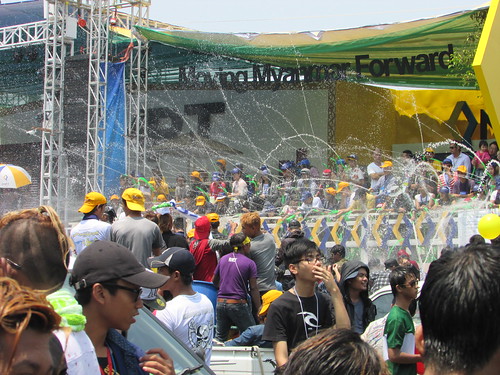A number of Asian countries celebrate the New Year with Water Festivals, where the throwing of water symbolises the washing-away of past sins. In Thailand and Laos, the festival is called 'Songkran' but in Myanmar it's 'Thingyan', described on Wikipedia here.
Getting wet on 14th April 2016
As described in the first post in this series Return to Rangoon, I arrived in Yangon early morning on the 1th April and my host, the Doctor, took me to see the temporary 'water throwing stations' erected in connection with the New Year -Thingyan. These exist in a wide variety of forms.
Within Yangon area, the simplest comprise one or more plastic waters barrels or, alternately, oil drums with the end cut off filled with water. The ‘water throwers’ are each equipped with a plastic bucket, a plastic bowl or a (usually battered) aluminium bowl. As the target, pedestrian or vehicle, approaches the bowl is ‘charged’ with water from the barrel allowing the target to be ‘baptised’ with water. There seemed to be an infinite variety of techniques, from the genteel splashing only a few drops of water to more aggressive but still good-natured producing a good soaking. I was reminded of the difference between the symbolic baptism of much of the Christian church and the total immersion practised by Baptists. Even the water barrel was not essential. In a few places I saw a rectangular frame made out of lengths of substantial bamboo lashed together with plastic rope and lined with heavy-duty polythene sheet to form a reservoir.
I quickly realised, as we drove across the city, that this type of ‘water throwing station’ could be made mobile, by loading it in the back of a standard pick-up truck, accompanied by an improbable number of water-throwers. To slightly lessen the chances of water-throwers falling off the crowded vehicle, most trucks had been fitted temporarily with a simple frame of four lengths of thick bamboo lashed together and wedged into the load space to raise the height of the sides. In fact, as we slowly negotiated the crowded streets it sometimes seemed as if every other vehicle was a ‘water throwing station’.
 Thingyan (Yangon, 2016).
Thingyan (Yangon, 2016).
Although the water-throwers varied – some trucks had a mix of age and gender - most were male teenagers in a ‘uniform’ of dark clothing, usually with a black baseball cap worn backwards and testing the truck suspension to destruction by dancing to some form of ‘ghetto blaster’.
Although the roadside ‘water throwing stations’ were sometimes silent, when sound systems were fitted they could be less inhibited than on vehicles and many locations featured a wall of loudspeakers producing an exceptionally loud modern dance beat.
Even simple roadside water throwing stations were often provided with shelters – the inevitable bamboo lashed together with a plastic roof tied-on. These constructions were often embellished with palm fronds. Increasing sophistication appeared to be linked to commercial sponsorship –larger stores had their own water throwing stations, sometimes with uniformed staff. A ready supply of mains water encouraged the use of hoses, rather than water bowls. Temporary plastic plumbing at the side of the road produced a ‘fire-main’ to which perhaps ten or twenty lengths of garden hose could be attached, each manned by a separate water-thrower.
The pick-up trucks appeared to queue-up at roadside water-throwing stations for their turn to ‘duel’ the fixed water throwers.
The Doctor parked a few hundred yards from the main water-throwing stations in Pyay Road and we joined the throng of pedestrians. We had to ‘run the gauntlet’ of a number of smaller water-throwing stations to reach the main road so, needless to say, I ended up wringing wet from head to foot (I saw very few Europeans so I imagine an elderly white woman presented an irresistible target). My conclusion is that a well-aimed bucket of water is a match for a number of poorly-directed hoses. The temperature was 42 or 43 degrees Celsius so I expected to start drying out but when we eventually arrived back at the Doctor’s house I was still encased in a mass of sodden clothing.
The main road represented a further escalation in scale as the closely-packed water-throwing stations were sponsored by some of the major companies in Myanmar and it appeared that no expense had been spared. Each station was built in the manner of a ’stage’ at an outdoor music festival, constructed from standard scaffolding providing multiple levels and topped with a proscenium arch equipped with modern computer-controlled lighting. The lower level invariably featured a battery of perhaps 50 hoses, manned by enthusiastic water-throwers who, I was informed, had paid 125 American dollars for a 5-day ticket. A few of the hoses had extra capacity and were more like fire hoses. Of course, all the water discharged had to find its way into the street drains, leaving the road awash to a depth of a few inches.
 One of the major commercially-sponsored water-throwing stations in Yangon.
One of the major commercially-sponsored water-throwing stations in Yangon.
Each stage had its own live performers, blasting away at a high decibel level, apparently oblivious to the adjacent stages, delighting the mainly young (and wet) crowd dancing in the street. This was not a side of Burma I had seen before! There were plenty of police in attendance but they seemed to be keeping a watching brief. The opposite side of the road was lined with food and sales stalls (sales of waterproof pouches for a mobile phone to hang round the neck seemed particularly strong). Beyond the vendors, an embankment rose up to Inya Lake, finally revealing where all this water was coming from. I spotted a whole series of high capacity plastic pipes snaking down the embankment from the lake and disappearing under the road which presumably provided the source of the water-driven mayhem.
 The MPT-sponsored water-throwing station.
The MPT-sponsored water-throwing station.
I barely noticed the additional dousing as we walked back to the car. Back at the Doctor’s home, I had a shower, changed and was happy to comply with Doctor’s recommendation that I relax (or at least limit myself to computer work) for the rest of the day.
Related posts
Next post on this trip.
All my posts on this trip can be found here.
My pictures
There's an album of pictures showing Thingyan in Yangon here.
All my pictures on this trip are in the collection Burma, 2016.
[Picture references amended 10-May-2016, 26-May-2016]
